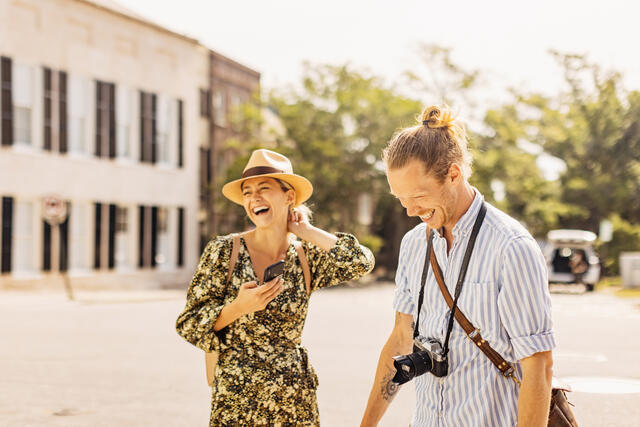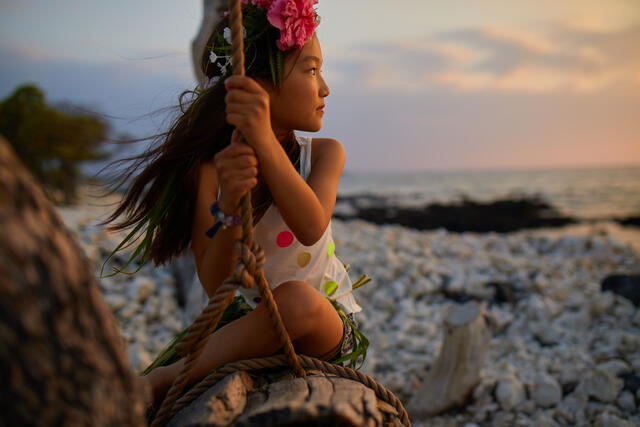You don't have to be a professional photographer or videographer to freeze memorable vacation moments in time.
What's more, you don't even need any special equipment. Joe Switzer, a filmmaker based in St. Louis, Missouri, says that these days, just about everyone has the power to be a professional photographer in the palm of their hand. Smartphone cameras today are capable of capturing images comparable to those from DSLRs — in some cases, like in low-lighting scenarios, the latest and greatest smartphone cameras can even outperform some pro-grade equipment.
Discover how to take good vacation photos with these travel photography tips for beginners.
1. Don't Forget to Photograph People
Yes, the Grand Canyon is stunning. But so are your kids when they see it for the first time.
“Take pictures of the view in front of you, but take the cheesy selfies, too," says Jordan Carnegis, a photographer and artist based in Orlando, Florida.
“You can Google a picture of Yellowstone, but you can't Google your kids' [reactions to it].Take the time to focus on the people you're with and the memories you're making. I think that's what people miss the mark on most."
Carnegis and Switzer recommend capturing the scenery first, then swapping people in or out. “Any time that you have a beautiful scene — a sunset on the beach with magic clouds and a rainbow and jumping dolphins — it's like, 'I have to get a quick picture of that!'" says Switzer. “But get the kids, get the family, take the selfie immediately. Take two seconds to [capture both scenes]." Then you have the option of using that perfect shot with or without your crew.
Just don't forget the photographer. “Make sure you get photographs of everybody," says Carnegis. “If you're the photographer, make sure you include yourself."
2. DO Forget About Social Media

Focusing exclusively on what you think will garner the most "likes" on social media doesn't always translate to the best photos. Neither Carnegis nor Switzer shoot with Instagram in mind.
Instead, they suggest that amateur photographers think like photojournalists. “Photograph the moment as it happens," says Carnegis. “Keep it organic. Keep it loose. Keep it candid." It doesn't matter if it's perfect.
You can always choose your best shots to post to Instagram later. “I treat Instagram like a portfolio of the best of the best," says Switzer.
This works for video, too, especially when capturing “in-between" moments, adds Switzer. “Walking through the airport, buckling up on the plane, the little one rolling her little suitcase to the taxi..." he says. “The in-between stuff is really fun with video."
Sometimes that means anticipating the magic. “You know when kids are going to experience a 'first,'" says Switzer. “The first time I took my daughter on a roller coaster, I turned the camera on and just waited. I knew her belly had never felt a drop before. I like to get those authentic moments."

3. Follow the Light
Shooting into the light is the biggest mistake Switzer sees amateurs make in their vacation photos. Taking pictures or videos with light behind the subject, rather than in front, exposes the background but leaves faces darkened by shadows. “It's all about the light," says Switzer. “Always turn your subject to let that light hit it. Always look at the light."
What if the one shot you want is directly into the sun? Tap on your subject in portrait mode, says Switzer. “That'll help blur everything out back there and really focus on that face."
Whatever you do, don't use flash. “Just turn your flash off," says Switzer. Look for ambient light around you instead. “We always look for street lights," he says. Another option is to find a pool of light on the ground and step into it. In a pinch, Switzer suggests using “night mode" on your phone as an alternative to flash.
4. Learn the "Rule of Thirds"
Learning basic composition will make a world of difference when you're putting together those travel albums. Instead of centering your subject in the frame, employ the “rule of thirds," suggest both Carnegis and Switzer.
Here's how to put the concept into practice: Place your subject in the righthand, lefthand, top or bottom third of the image. Be sure to move your hands left or right, just a little off-center. “It makes it so much more interesting than just a stagnant, 'Here I am in front of the Golden Gate Bridge,'" says Carnegis.
Some phones and cameras have a grid setting to help you visually divide your image into nine equally sized areas with three rows and three columns. Place your subject along the dividing lines around that center square.
“This is hard because your brain tells you to keep people in the center," says Switzer. “But if you watch a lot of movies, you'll notice everyone's usually off to the left or right."
5. For Video, Less Is More
When capturing video, less is best. That means less time and movement.“Let the scene speak for itself," urges Switzer. Film in short three- to five-second bursts throughout the day. Once an hour or when you change locations, take a snippet of video. “This is super easy, and it's not going to take a bunch of time," he adds.
You can make your footage more professional-looking by holding the camera still or resting it on a stable surface that serves as a makeshift tripod. “No one likes watching shaky footage," he notes.
Try to capture a few different elements of the scene. “You want variety... Show a close-up of somebody. Show a wide shot of where you are. Show a mid shot of the seagulls coming down and eating the bread the kids threw out on the water."
Or focus just on the highlights. If you're riding a roller coaster, film the first big drop instead of the whole wobbly ride. “It's the icing, the coolest part," says Switzer. Then you can edit the day's best moments into a one-minute montage.
6. Use Your Phone's Camera Instead of the One Built Into Apps
When snapping photographs, always use your phone's camera instead of the one built into Instagram, Snapchat or other apps, says Carnegis. “[These apps] shrink the original image size and are terrible for printing."
The same applies to editing. Those apps won't save a high-resolution copy, Carnegis cautions, so use your phone's built-in editing tools. Switzer suggests brightening the background or faces a bit, adding contrast or a hint of saturation, lightening shadows or adjusting exposure.
You can also use an app that simplifies photo editing, like A Color Story or Snapseed, says Carnegis. “You can drop in 10 photos and edit them all the same."
7. Play With Your Phone's Features
For most photos, your phone's regular camera mode will do just fine, says Switzer. But for capturing people and close-up objects, you can't beat portrait mode.
“If you want to look like a professional photographer, the number one thing you can use on your phone is the portrait mode," he explains. With a simple finger tap, portrait mode will blur the background to make your subject pop.
For stunning scenery, turn to panorama. “In those grand, 'holy cow' moments — look at that sunrise, look at that waterfall — use the panorama mode on your phone to show the whole scene," says Switzer. “You can really see just how grand and big and beautiful your vacation spot was."
Carnegis notes you can use panorama for vertical shots to add dramatic effect, too.
Just be sure to play with your phone's features and settings before you leave if you want to learn how to take good vacation photos. “Don't wait until you're on the trip to start figuring out what your camera can do," says Carnegis. “Play around at home."
8. Pick a Theme
One of Carnegis's favorite travel photography tips for beginners is to find a theme.
“Pick something to photograph each trip — old house numbers or vintage cars. Or, collect five items for each city: a coin on the sidewalk, a bloom from a morning walk, a coaster from a night spent with great friends or an oyster shell found on the
beach," she says. Line them up in rows and photograph them into one singular image. "Those five little items tell the story of your day more than a selfie at dinner."
Over time, you'll have a richer trove of travel memories. “Imagine the group of images you could have in 10 years to speak of your adventures," she says.
9. Put the Phone Down Once in a While
Finally, it's important to realize that you don't have to capture every waking moment. “There are extremes from 'We don't have a single picture of this trip!' to 'We have photos of every single thing we ate,'" says Carnegis. “Just pick the best things to shoot. You don't need a video of the whole birthday song. Just take a couple of snips."
You want to enjoy your vacation, not just document it. Being more selective about what you photograph can be key to how to take better travel photos. So be sure to put your camera away from time to time, too.
Read "8 Most Instagrammable Places to Visit on Your Virginia Beach Vacation" for more inspiration for your best travel photos.